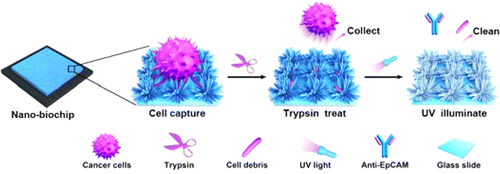
The advanced nanobiochips have been widely employed in diagnosing some high incidence of diseases because of their portable, low-cost, and highly sensitive features. However, the subsequent disposal of these wastes remains unexposed, probably giving rise to serious environmental pollution and health risks similar to traditional biomedical waste. Here, we have presented a TiO2 nanosisal-like coating for disposing nanobiochip waste via the photoresponsive self-cleaning features of the nanobiochip, demonstrated by the nanochips of cancer detection. Moreover, the high specificity and sensitivity of nanochips can be maintained by integrating unique nanostructured coatings (i.e., nanosisal-like coating) with specific recognition molecules (i.e., anti-EpCAM). Therefore, this study will provide a promising strategy for the design and management of practical nanobiodevices, thereby eliminating the old path “pollute first, clean up later”. ACS Nano, 2015 |

